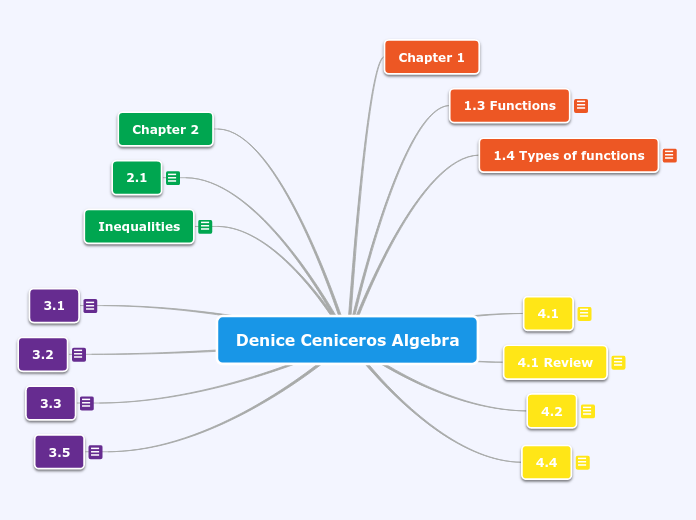作者:Denice Ceniceros 6 年以前
348
mat151

作者:Denice Ceniceros 6 年以前
348

更多类似内容
Transformation of a graph
More with imaginary numbers
Note: i= Sqrt -1 , i^2=-1
If a>0 , then sqrt -a = i sqrt a
Example: sqrt -16 Example: sqrt -3 X sqrt -3 | isqrt-3 X -isqrt3
=i sqrt 16 sqrt 9 | i^2sqr3 Xisqrt3
=4i =3WRONG | -1 (3) = -3 RIGHT
Example: 2 +_sqrt-24 Example: sqrt -2 X sqrt -8
2+i sqrt 24 /2 =i sqrt 2 X sqrt 8
2+isqrt 24 /2 i^2 sqrt 16
2+i sqrt 4 sqrt -1 (4)
=-4
i = sqrt -1 i^2=-1
Example: i+i=2i Example: 5i-3i=2i
Example: 5i X 3i= 15i^2 = 15(-1) =-15
Example: 5(-4i)= 20i Example: -6(2i-1)=12i+6
Example: 3i/21= 3/2 Example: (2i+1) (2i-1)= 4i^2-2i+2i-1
=4i^2 -1=4(-1)-1= -5
Complex Conjugates
Check Notebook
Complex Conjugates
3 . 4+i/5-i X 5+i/5+i = 20+5i+4i+i^2/ 25-i^2
= 20+9i-1/25+1 = 19+9i/26
Complex Numbers and Exponents
i= Sqrt -1 , i^2=-1 , i^3 = i^2 X i =-1 X i =-i
i^4 =1 , i^5=i^4 X i =i , i^6= i^4 X i^2= -1
i^12= (i^4)^3= 1^3=1 i^50=(i^5)^10= i^10
=(i^2)^25=(-1)^25 = -1
Quadratic Formula
x= -b+- sqrt b^2-4 ac/2a
Graphically- X intercepts
(2 of these)
(1 of these)
Analysis
the Discriminant b^2-4ac
b^2-4ac > 0 2 real solutions
b^2-4ac=0 1 real solution
b^2-4ac <0 2 imaginary solutions
As long as the equation is of the form ax^2+bx+c=0 , I can use the quadratic formula.
Other ways to solve
Example 1: x^2 -8x +9 =0 1. Move the constant to the other side
x^2 -8x=-9 2. (b/2)^2 (8/2)^2=16
(x^2-8x +16)-16 =-9 3. Add and Subtract (b/2)^2
(x-4)(x+4)=-9+16
Sqrt (x-4)^2 = Sqrt 7 4. Put in vertex form
x-4 = +_ sqrt 7 5. Take square root
Example 2: x^2 - 8x=7 IN NOTEBOOK
Example 3: 3x^2 -6x +z=0
When a=/ 1 ...
3x^2 - 6x= -2
3( x^2 -2x ) =-2
3( x^2 -2x +1 -1)=-2
3(x^2-2x+1)+3(-1) =2
3(x-1)^2 = -2+3
3(x-1)^2 =1
(x-1)^2 =1/3
x-1=+_ Sqrt 1/3
x= 1+_ Sqrt 1/3
Factoring when factorable
Example: 2x^2 +2x-11=1
2x=^2+2x-12=0
2(x^2+x-6)=0
2(x-2)(x+3)=0 Divide by 2
(x-2)(x+3)=0
x-2=0 x+3=0
x=3 x=-3
If a>0, then upwards parabola
If a<0, then upside down parabola
Ex: Desmos
D:(-infinity, infinity)
{x|-infin. <x<infin.} - all real #'s
R: [0,inin.)
Increasing: (-infin.,0) Decreasing: (0,infin.)
4 . Verex Form
(h,k) vertex
Ex: Find the equation given the vertex and a point on the curve.
V= (0,3) (2,1)
Need to find a and the vertex
1=a(2-0)^2+3
Answer: f(x)=-1/2(x-0)^2+3
f(x)= -1/2 x^2+3
Find the equation given
V=(-2,4) and (3,6) Answer: F(x)= 2/25(x+2)^2
6=a(3+2)^2+4
2=a(5)^2
2/25=a
Find the function form given standard form
Ex: f(x)=2x^2-4x+1
Ex: b=4 a=2 x= --4/2(2)=1
f(1)= 2(1)^2-4(1)+1= -1 V=(1,-1)
x+3x-2<4 --> 4x-2<4
4x<6 --> x<6/4=3/2 I.N = (-3,infinity)
2 . Two variables
Graph to find the solution set
y<3x+2 Test Point (-2,3) --> 3<3(-2)+2__ FALSE
3 . 2x+3y>_ -4
4 . Absolute Value
|2x|=3
2x=3 or 2x=-3
5 . -2 |5x+10|=-4
-2/-2|5x+10| =-4/-2
|5x+10|<_ 2
5x+10=2 or 5x+10=-2
x<_ -8/5 x>_ -12/5
2.1 Linear Functions
Types of lines
Graphing
y=-2x+3
Parallel Lines-
Perpendicular-
Find the equation Given...
m= 0-5/1-2= -5/-1 =5
y-0= 5(x-1)
y=5x-5
2 . A point and the slope
Ex: (3,8) m=4/3
y-8= 4/3 (x-3)
y= 4/3x +4
3 . Line parallel to given line
y-0= -1/2 (x-0)
y=-1/2x
4 . Line perpendicular
m= 3/4 m2= -4/3 through (0,-3)
y--3= -4/3 (x-0)
y+3= -4/3x
y=-4/3 x-3
Real zeros of higher degree polynomials
Example: reps a
Small country's bird population , x days after May 31st.
Find the date(s) when the population was 5000. Find X when when f(x)= 5000 See Notes
Factoring to find zeros f(x)=ax^2+bx+c
F(x)= x^2-3x+2
0=(x-1)(x-2)
x-1=0 x-2=0
x=1 x=2
Zeros with Multiplicity (factored form) Graph
Example: f(x)=(x+2)^3 Example: F(x)= (x-4)^3(x+1)
=(x+2)(x+2) x=2 =4 Multiplicity
x=-1
Complete Factored Form
a) f(x)= 13x^2 -13x-26 b) f(x)=7x^3-2|x^2-7x+2|
GCF = 13 13(x^2-x-2) GCF= 7 (USe grouping method)
=13(x-2)(x+1) 7(x^3-3x^2)-(x-3)
0=13(x-2)(x+1) x=2 x=-1 7 [(x^3-3x^2)-(x-3)]
7[x^2(x-3)-(x-3)]
7(x-3)(x^2-1)
7(x-3)(x-1)(x+1) X=3,1,-1
C) F(x)=2x^3-4x^2-10x+12 (Use Graph)
Factoring Continued
a) f(x)= 2x^3-2x^2-34x-30 with given zero See Notes
If remainder = 0 ... TRUE FACTOR
Rational Zeros (Not all whole # zeros)
Let f(x)=
Polynomial Functions and Models
Example: See note book
Intercepts (x and y intercepts)
Example: See notebook x- intercepts (y=0)
zeros
Example: see notebook and desmos
3 . Piece wise Functions
F(x)= {x x>2 Slope=1
{2 x<_2 y-int=0
^ See notebook
{2x x>0
{x+2 x<0
Project - Compound Interest
FV=PV(1+i)^n
F+P(1+r)^t
#1 and 2# YOU TRY IT
F(x)+ax^2+bx+c F(1+r)^2+b(1+r)+c
Non Linear Functions
Symbolic Form for a polynomial
Example: y=mx+b OR f(x)=mx+b
F(x)= ax^m+bx^m-1+cx^m-2+. . . .
Graphs
Min and Max , Absolute Min , Absolute Max , Local Min , Local Max
Example: See Desmos
F(x)--> -infinity as x-->- infinity
F(x)--> infinity as x--> infinity
Example: See Desmos
Minimum - (-1.404,-3.557) Maximum - (0.5,0)
Increasing: ( Decreasing:
Domain: Range:
Types of Functions
Linear
Symbolic Form- y=mx+b (Slope intercept form)Highest exponent degree is 1.Ex: y=3x+1(Vertical Line)x=2 (a line that is NOT function)(Horizontal Line) y=2 (is a function)
Quadratic y=ax^2+bx+cHighest Degree is 2.Ex: 1a. 1b. a>02a. a<02b.
Cubic(a,b,c,d are constants)Highest exponent is 3. a>0 -- Regular parabolaa<0 -- Upside down parabola
QuarticDegree is 4.Ex:a>0 --a<0 --
Rationalx-h DOES NOT EQUAL 0Ex:
Exponential(a,b are constants)Ex: , Ex: ( e is a constant)Ex: Logarithmic Absolute Value FunctionsEx: Average rate of change- (Slope)Ex: (1,3) find average{interval} rate of change(-3,-2)Difference Quotient = Ex: (0,2) f(0)=32f(2)= 0
1.3 Functions and their representations
Definitions: